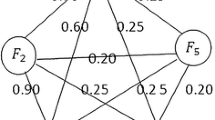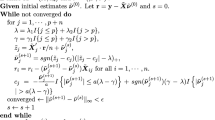Abstract
Lasso is a popular method for high-dimensional applications in machine learning. In this paper, we propose a novel variant of Lasso, named self-weighted Lasso (SWL). Self-weighted means that the weights are obtained based on the correlations of features and output, which is only related to the data itself. SWL inherits the extraordinary properties of Lasso, which means that it has the function of feature selection and continuous shrinkage simultaneously. Meanwhile, SWL ensures that the solution is consistent for feature selection, which improves the performance of Lasso. However, there are still huge challenges when training large-scale data with SWL. To improve the efficiency of SWL, especially for large-scale and high-dimensional problems, we propose an efficient acceleration strategy. It belongs to the state-of-the-art safe screening methods, which can significantly reduce the training time without sacrificing the accuracy. Experimental results on twelve benchmark datasets and a practical dataset verify that the SWL has better performance in comparison with other state-of-the-art regression algorithms, and the proposed safe screening rule has excellent efficiency.









Similar content being viewed by others
Explore related subjects
Discover the latest articles, news and stories from top researchers in related subjects.References
Tibshirani R (1996) Regression shrinkage and selection via the Lasso. J R Statist Soc Ser B 58 (1):267–288
Chen SS, Donoho DL, Saunders MA (1998) Atomic decomposition by basis pursuit. SIAM J Sci Comput 20(1):33–61
Bruckstein AM, Donoho DL, Elad M (2009) From sparse solutions of systems of equations to sparse modeling of signals and images. SIAM Rev 51(1):34–81
Chen SB, Zhang YM, Ding CHQ, et al. (2019) Extended Adaptive Lasso for multi-class and multi-label feature selection. Knowledge-Based Systems 173:28–36
Lee JD, Sun DL, Sun Y, Taylor JE (2016) Exact post-selection inference with application to the Lasso. The Annals of Statistics 44(3):907–927
Cui C, Wang D (2016) High dimensional data regression using Lasso model and neural networks with random weights. Inform Sci 372:505–517
Zhao W, Beach TH, Rezgui Y (2019) Automated model construction for combined sewer overflow prediction based on efficient Lasso algorithm. IEEE Trans Syst Man Cybernet Systems 49(6):1254–1269
Xie Z, Xu Y (2014) Sparse group LASSO based uncertain feature selection. Int J Mach Learn Cybern 5:201–210
Donoho DL, Huo X (2001) Uncertainty principles and ideal atomic decomposition. IEEE Trans Inf Theo 47(7):2845–2862
Donoho DL, Elad M (2003) Optimally sparse representation in general (nonorthogonal) dictionaries via l1 minimization. Proceedings of the National Academy of Sciences 100(5):2197–2202
Donoho DL (2006) For most large underdetermined systems of linear equations the minimal l1-norm solution is also the sparsest solution. Comm Pure Appl Math 59(6):797–829
Meinshausen N, Bühlmann P (2006) High dimensional graphs and variable selection with the LASSO. Ann Statist 34(3):1436–1462
Leng C, Lin Y, Wahba G (2006) A note on the Lasso and related procedures in model selection. Statistica Sinica 16(4):1273–1284
Zou H (2006) The Adaptive Lasso and its oracle properties. J American Statistical Association 101(476):1418–1429
Lian L, Liu A, Lau VK (2018) Weighted Lasso for sparse recovery with statistical prior support information. IEEE Trans Signal Process 66(6):1607–1618
Su M, Guo Y, Men C, Wang W (2019) A robust self-weighted SELO regression model. Int J Mach Learn Cybern 10:3189–3199
Breheny P, Huang J (2011) Coordinate descent algorithms for nonconvex penalized regression, with applications to biological feature selection. Ann Statist 5(1):224–244
Madigan D, Ridgeway G (2004) Least angle regression: Discussion. Ann Stat 32(2):465–469
Daubechies I, Defrise M, Mol CD (2004) An iterative thresholding algorithm for linear inverse problems with a sparsity constraint. Commun Pure Appl Math 57(11):1413–1457
Bioucas-Dias JM, Figueiredo MA (2007) A new twIST: Two-step iterative shrinkage/thresholding algorithms for image restoration. IEEE Trans Image Process 16(12):2992–3004
Ghaoui LE, Viallon V, Rabbani T (2012) Safe feature elimination in sparse supervised learning. Pac J Optim 8:667–698
Bonnefoy A, Emiya V, Ralaivola L, Gribonval R (2015) Dynamic screening: accelerating first-order algorithms for the Lasso and group-Lasso. IEEE Trans Signal Process 63(19):5121–5132
Fercoq O, Gramfort A, Salmon J (2015) Mind the duality gap: safer rules for the Lasso. In: Advances in the 32nd international conference on machine learning, pp 333–342
Liu J, Zhao Z, Wang J, Ye J (2014) Safe screening with variational inequalities and its application to Lasso. In: Advances in the 31th international conference on machine learning, pp 289–297
Mei B, Xu Y (2020) Safe sample screening for regularized multi-task learning. Knowledge-Based Systems 204:106248
Ndiaye E, Fercoq O, Gramfort A, Salmon J (2015) GAP safe screening rules for sparse multi-task and multi-class models. In: Advances in the 32th international conference on machine learning, pp 811–819
Cao Y, Xu Y, Du J (2020) Multi-variable estimation-based safe screening rule for small sphere and large margin support vector machine. Knowledge-Based Systems 191:105223
Shibagaki A, Karasuyama M, Hatano K, Takeuchi I (2016) Simultaneous safe screening of features and samples in doubly sparse modeling. In: Advances in the 33nd international conference on machine learning, pp 1577–1586
Wang H, Xu Y (2018) Scaling up twin support vector regression with safe screening rule. Inform Sci 465:174–190
Wang J, Zhou J, Wonka P, Ye J (2013) Lasso screening rules via dual polytope projection. In: Advances in neural information processing systems, pp 1070–1078
Zhang W, Hong B, Liu W, Ye J, Cai D, He X, Wang J (2017) Scaling up sparse support vector machines by simultaneous feature and sample reduction. In: Advances in the 34th international conference on machine learning, pp 4016–4025
Wu W, Xu Y (2019) Accelerating improved twin support vector machine with safe screening rule. Int J Mach Learn Cybern 10:3587–3600
Pan X, Pang X, Wang H, Xu Y (2018) A safe screening based framework for support vector regression. Neurocomputing 287:163–172
Pan X, Yang Z, Xu Y, Wang L (2018) Safe screening rules for accelerating twin support vector machine classification. IEEE Trans Neural Netw Learn Syst 29(5):1876–1887
Wang H, Pan X, Xu Y (2019) Simultaneous safe feature and sample elimination for sparse support vector regression. IEEE Trans Signal Process 67(15):4043–4054
Boyd V (2006) Faybusovich, Convex optimization. IEEE Trans Automat Contr 51(11):1859–1859
Beck A, Teboulle M (2009) A fast iterative Shrinkage-Thresholding algorithm for linear inverse problems. SIAM J Imaging Sci 2(1):183–202
Florea MI, Vorobyov SA (2017) A robust FISTA-like algorithm. In: 2017 IEEE international conference on acoustics, speech and signal processing (ICASSP), New Orleans, LA, pp 4521–4525
Tang L, Tian Y, Yang C (2018) Nonparallel support vector regression model and its SMO-type solver. Neural Netw 105:431–446
Rastogi R, Anand P, Chandra S (2017) L1-norm twin support vector machine-based regression. Optimization, pp 1–17
Hamidieh K (2018) A data-driven statistical model for predicting the critical temperature of a superconductor. Comput Mater Sci 154:346–354
Acknowledgments
The authors would like to thank the reviewers for their valuable suggestions to improve this paper. This work was supported in part by the National Natural Science Foundation of China (NO. 12071475, 11671010) and in part by the Beijing Natural Science Foundation (NO. 4172035).
Author information
Authors and Affiliations
Corresponding author
Additional information
Publisher’s note
Springer Nature remains neutral with regard to jurisdictional claims in published maps and institutional affiliations.
Rights and permissions
About this article
Cite this article
Xiao, X., Xu, Y., Zhang, Y. et al. A novel self-weighted Lasso and its safe screening rule. Appl Intell 52, 14465–14477 (2022). https://doi.org/10.1007/s10489-022-03316-7
Accepted:
Published:
Issue Date:
DOI: https://doi.org/10.1007/s10489-022-03316-7




